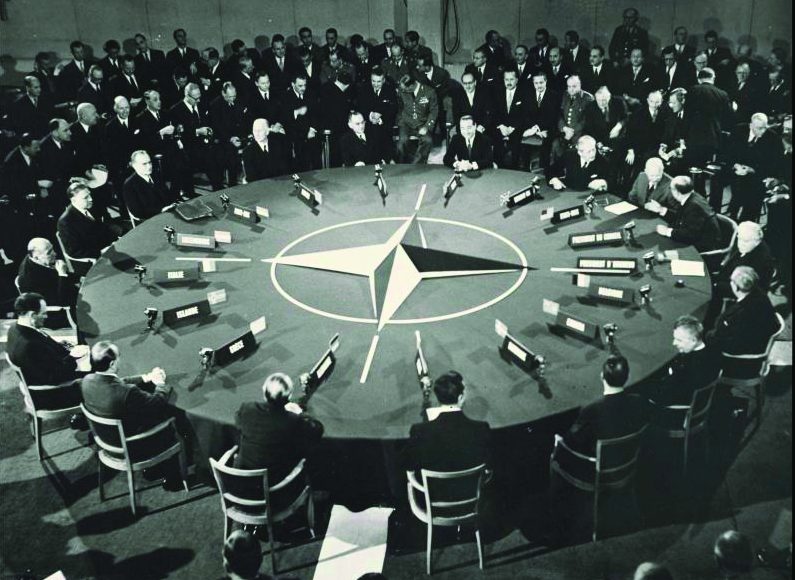In July 1944, as the US government concluded that a decisive Allied victory in the Second World War was certain, it organised the Bretton Woods Conference to ensure a US dominated post war global financial system. The Bretton Woods Agreement made the dollar the global reserve currency – it pegged the US dollar to gold at $35 per ounce and pegged all other currencies to the dollar. The conference established the International Monetary Fund (IMF) to force balanced trade between participating countries and the World Bank, to lend dollars for post-war reconstruction. By 1952, the dollar had overtaken the British sterling as a global reserve asset. Armed with the most powerful currency and the global financial institutions to enforce its use, US imperialism was now in a position to assert its interests globally.
At the end of the war, Europe was decimated and divided. The Soviet Union had liberated eastern Europe from fascist occupation; France lay plundered, Italy ruined, and Germany was divided between the USSR in the east and the Anglo-American forces in the west. Communist partisans with popular support were active in Greece, Italy, Yugoslavia and France because they had led resistance to fascist occupation. In response, British and US imperialism moved to suppress these parties after the defeat of Hitler. By 1947, the Italian Communist Party (PCI) had grown to over two million members. The PCI took part in every government from June 1944 to May 1947 and was then excluded under pressure from US Secretary of State George Marshall, who made anti-communism a pre-condition for receiving US aid. The French Communist Party participated in the provisional governing Tripartite alliance 1944 to 1947, but was then also excluded through direct US pressure. However, between 1945 and 1950 socialist governments were established across central and eastern Europe in: Albania, Bulgaria, Czechoslovakia, the German Democratic Republic (GDR), Hungary, Poland, Romania and Yugoslavia. On 5 March 1946, Winston Churchill delivered the Iron Curtain speech in Fulton, Missouri – essentially a declaration of the Cold War on the Soviet Union. This would signal the beginning of imperialism’s offensive against communism, however, the economic and political situation meant that it would be US imperialism that would take the lead.
US imperialism triumphs
Towards the end of the war, British imperialism was virtually bankrupt. It was forced to liquidate around half its foreign assets to pay for the war so it didn’t have enough invisible income to offset its balance of payments deficit which stood in the billions. From 1941 the US had financed Britain’s war effort through Lend-Lease, a scheme where the US granted loans and war materials, while with ‘reverse lend-lease’ Britain supplied US troops with one third of their supplies and equipment. The position of US imperialism had never been stronger. It had a significant trade surplus and had been left domestically unscathed due to delaying its entrance into the war until 1941.
Conditions were ripe for a new round of capital accumulation. Massive amounts of capital (factories, machinery, infrastructure) were destroyed during the war itself; the working class in the fascist countries (Italy, Germany, Spain and Japan) had suffered devastating defeats, organised labour was effectively smashed, so they had little capacity to resist the economic restructuring that was to come; and open inter-imperialist rivalries were alleviated. This was due to the economic dominance of the US, which after the war controlled 48% of world trade, produced around half of the world’s manufactured goods, held two-thirds of the world’s gold stocks and produced two-thirds of the world’s oil. Militarily, US imperialism was unmatched due to its possession of the atomic bomb. There was also the ‘threat’ of socialism spreading from the Soviet Union so US imperialism’s European rivals were forced to fall in line.
In order to buy social peace and ensure western Europe could play its role in ‘containing’ the Soviet Union, US imperialism had to set about restructuring Europe. In response to a socialist government being established in Czechoslovakia in 1948, the US instigated the Marshall Plan which gave $13bn in development assistance to 16 European countries, the majority going to Britain, France, Italy and occupied Germany. This was the first step towards European integration; the Organisation of European Economic Integration (OEEC) was formed to co-ordinate Marshall Aid, facilitate use of the dollar and eventual convertibility between European currencies, to build a united front against communism.
The question of Germany was crucial in stabilising western Europe. The US Morgenthau Plan proposed dividing Germany, deindustrialising it, demilitarising it and turning it into an agrarian country which would have led to about 25 million Germans starving to death. By 1947 the position was changed, western Germany was instead rejuvenated economically in order to be a bulwark against communism. West Germany was officially established in 1949 and the GDR was established that same year.
The conditions outlined above, Marshall Aid, the looting of the colonies and the super-exploitation of migrant labour resulted in the post-war boom for imperialist countries: high profit rates, rising labour productivity, rising real wages and easy access to credit allowed for concessions such as welfare and full employment to keep the working class on side and buy off organised labour. US finance capital took advantage of this by acquiring shares in European industry.
Anti-communist reaction
In 1945 Britain had military personnel occupying Vietnam, Greece and Indonesia. These countries had liberation movements either led by communists or revolutionary nationalists. It fell to US imperialism ultimately to find favourable solutions to these crises.
- In the 1945 Indonesian Revolution, British troops fought nationalist forces, using Japanese troops, until US and Dutch imperialism could impose a neocolonial settlement on the new republic.
- In Vietnam, 20,000 British troops entered Saigon in order to contain the communist Viet Minh. Putting down the insurrection was then left to French imperialism from 1946 which suffered outright defeat at the Battle of Dien Bien Phu in 1954. US imperialism then undermined the Viet Minh by partitioning Vietnam in 1955.
- In Greece, British imperialism fought desperately to put down the communist insurgency led by ELAS but the occupation became too expensive. It then fell to US imperialism to liquidate ELAS in 1947.
However, it was clear that imperialism could not impose its will everywhere. In 1949, despite US imperialism’s efforts, the reactionary Kuomintang government was overthrown in the Chinese Revolution and the People’s Republic of China was declared. Once a playground for imperialism, China was for now closed to imperialist profit-making.
At the British Labour government’s insistence, NATO was formed in 1949. Its main purpose was to threaten and isolate the USSR. Initially, NATO consisted of 12 countries, all in Europe and North America, and it would be a tool of US imperialism to further expand its influence. This was the case with Turkey and Greece. From 1946, US imperialism had built military ties with the Turkish state to establish a fascist paramilitary network. Being the gateway between Europe and the Middle East, Turkey is a key strategic country. Turkey joined NATO in 1952 during the Korean War and Greece joined that same year. With Greece and Turkey in NATO, the US had secured Europe’s eastern flank and encircled the Soviet Union.
NATO and the CIA were to take what was formed in Turkey – a semi-clandestine network of fascist paramilitaries with links to intelligence services, big business, the police and the military – and replicate it across Europe. During ‘Operation Gladio’, a series of ‘stay-behind networks’ were set up in: Belgium, Denmark, France, Greece, Luxembourg, the Netherlands, Norway, Portugal, Spain, West Germany and Italy. In Italy, Operation Gladio was instrumental in undermining the left. US imperialism had created economic stability in Europe to ensure social peace and now had the military arm to enforce it.
Towards a European imperialist bloc
In 1915, Lenin wrote:
‘Of course, temporary agreements are possible between capitalists and between states. In this sense a United States of Europe is possible as an agreement between the European capitalists … but to what end? Only for the purpose of jointly suppressing socialism in Europe, of jointly protecting colonial booty against Japan and America, who have been badly done out of their share by the present partition of colonies, and the increase of whose might during the last fifty years has been immeasurably more rapid than that of backward and monarchist Europe, now turning senile. Compared with the United States of America, Europe as a whole denotes economic stagnation.’ (On the Slogan for a United States of Europe)
For the European imperialists, this ‘temporary agreement’ was a recognition that they could not independently confront the Soviet Union nor compete with US imperialism. With military and political cooperation against communism in place, economic integration could be established. The US had encouraged European integration, particularly with Marshall Aid and the OEEC. For US imperialism, the economic bloc would complement its economic interests, namely a guaranteed market for US goods and investment. In his Iron Curtain speech Winston Churchill stated ‘The safety of the world requires a new unity in Europe’. However, still harbouring delusions of a Britain that could retain its empire, he did not want Britain to be part of it.
The European Coal and Steel Community (ECSC) was established in 1952 between Belgium, France, Italy, Luxembourg, the Netherlands and West Germany. France pushed for West Germany to be involved because it was rapidly re-industrialising and France did not want West Germany to become a military rival. The ECSC established a common market for coal and steel, removed trade barriers and encouraged the free movement of goods. Steel and coal production was put under the control of the High Authority. It also had a Parliament anticipating an expanded vision.
The 1957 Treaty of Rome, signed by the same six member countries, established the European Economic Community (EEC). The EEC gradually abolished internal customs duties and quotas, established a common external tariff, aligned labour laws between the countries and brought in coordination on monetary and economic policies. The European Investment Bank and the European Development Fund were also established, both institutions would serve as tools of European imperialism.
The establishment of the EEC meant that the member states would prioritise trade with each other rather than with their colonies, opening the colonies up to US imperialism. US imperialism was determined to see the breakdown of all colonial empires so that it could economically repartition the world in its favour. By 1930, US private foreign direct investment had surpassed Britain’s. Between 1938 and 1948, US goods were 25% of imports into European and Japanese colonies and US goods made up 15% of Africa’s imports despite US imperialism having no African colonies of its own. European colonialism was a fetter on US imperialism’s development and its ability to fully exploit these areas, thus it turned to slogans of ‘free trade’ and ‘self-determination’. However, such slogans were empty – actual self-determination for the colonies would have meant they could have chosen the path of socialism.
In reality, the process of European integration was part of managed decolonisation – a way for the European imperialists to grant independence while still keeping their (reduced) ‘fair share’ of the colonial plunder and suppress socialism. It would fall to the US to enforce this process for the benefit of imperialism as a whole.
Kotsai Sigauke
Continued in part II
FRFI 308 October/November 2025




